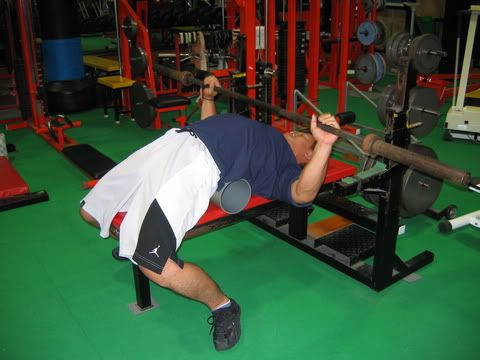Years ago, I posted the rules for a fictional gym, affectionately named "Moron's Gym" to Dr. Squat's message board. It was amended and corollaries were added later, but here are the original 20 rules:
 Welcome to MORON'S GYM! Here are the rules:
Welcome to MORON'S GYM! Here are the rules:1) Screaming as if achieving orgasm is encouraged on every repetition of every set. This will add "intensity" to your workout and will aid your progress.
2) At the completion of a set, weights must be dropped from a height no less than 4 feet. This will bend the weights, making them more ergonomically correct, as well as add "intensity" to your workout.
3) No sweating is allowed, unless you are wearing a tanktop or no top at all. In this case, only profuse sweating is allowed. Members may not wipe benches or equipment after use.
4) Machines are preferable to free weights. Free weights will be provided, but their use is highly discouraged for fear of injury or unsightly muscle gain.
5) If free weights are to be used, their use is limited to the following: barbell curls in the only existing squat rack, shrugs in the only existing squat rack, bench presses to the jugular, trampoline-chest bench presses, EZ bar curls, dumbbell curls, hammer curls, running man curls, curly fries, cable curls, french curls, zottman curls, and preacher curls.
6) Free weights are not to be returned to racks if used. This will take away jobs from gym staff and likewise hurt the national economy.
7) Weight lifting belts may be worn, but if used, they must be used for every set of every rep. They must not be taken off inbetween sets or when at the juice bar.
8) Spotting of others while lifting is generally discouraged, as this will be a liability concern. However, proper spotting technique dictates the generous usage of the following phrases yelled at maximum volume while deadlifting a barbell off of another member’s chest: “IT’S ALL YOU!!” and “YOU GOT IT, YOU GOT IT, YOU GOT IT!!!” (Note: Deadlifts are not allowed in Moron’s Gym, UNLESS when spotting someone doing jugular bench presses.)
9) Members must watch themselves in the mirror on every repetition of every set, as well as in between sets. In fact, more time should be spent looking in the mirror than working out. Failure to follow this rule will likely lead to overtraining.
10) Moron's Gym has a strict dress code. Gym wear is limited to the following articles of clothing: tanktops, baggy shorts pulled down to mid-thigh, colorful print baggy pants, bright neon lycra, do-rag/bandanas, T-shirts advertising beer, fraternity baseball caps, apparel with “Big Dog” or “No Fear” logos, high school championship commemorative T-shirts, and sunglasses.
11) More time must be spent talking about training, supplements, and other gym members than actually training. This is to be done by shouting at each other in a boisterous, arrogant manner. Failure to follow this rule will likely lead to overtraining.
12) Silent hostility among gym members is mandatory. Exceptions can be made for lovers who grope each other in between sets, when giving unsolicited advice (See Rule #15), and when following rule #11.
13) Time not spent lifting or staring at one's self in the mirror shall be spent viewing other gym members of the opposite sex in a lecherous manner. However, if eye contact is made, you must pretend that you were not looking at said gym member.
14) No chalk is allowed in Moron's Gym. However, gloves are encouraged to be worn at all times while in the gym and washroom facilities.
15) Unsolicited advice should be given to other gym members at any time you deem appropriate. Unsolicited advice will be most helpful when given WHILE someone is lifting. Advice can be based purely on conjecture or opinion and need not be based on experience or research.
16) Sharing of equipment and weights is prohibited at Moron’s Gym. There is to be no “working in”. If another member asks to “work in”, you must reply “I just have a few sets left.”. Monopolization of gym equipment is encouraged as progress is directly proportionate to the amount of time spent near fitness equipment.
17) Deodorant is discouraged at Moron’s Gym. Natural body odor which has been allowed to ferment for several days is preferable. However, copious amounts of cologne, perfume, or body splash are also encouraged. Perfume and cologne may be reapplied in between sets or glimpses of self in the mirror.
18) The all-weather cardio theater has been provided for gym member use and members are encouraged to use the cardio equipment when the weather is sunny and pleasant.
19) All gym members must insist that they could be professional/world-class athletes if they used steroids, creatine, protein, Cell-Tech, Hydroxycut, ginseng, or vitamins. This is the only reason why every member at Moron’s Gym is not a professional/world-class athlete.
20) Rules may be changed in any manner deemed appropriate or inappropriate at anytime for any reason by Moron’s Gym management.





















